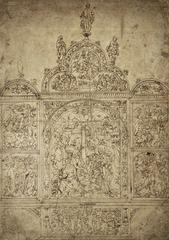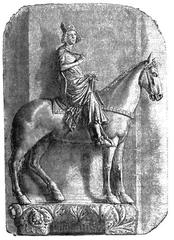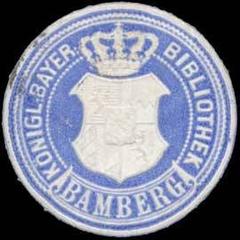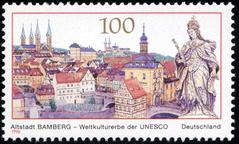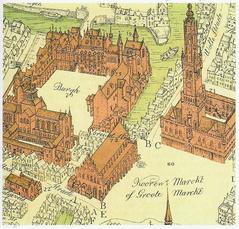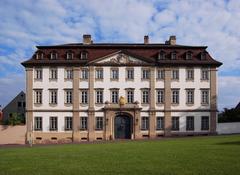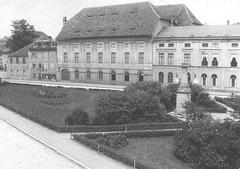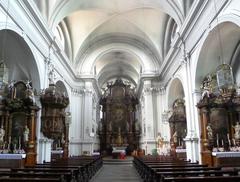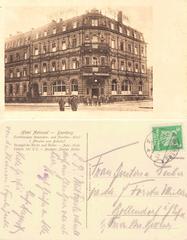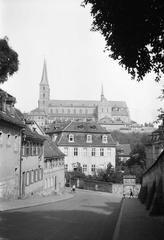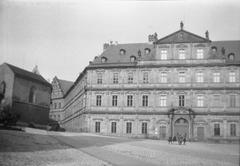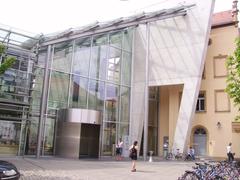Siechenscheune Bamberg Visiting Hours, Tickets, and Historical Sites Guide
Date: 14/06/2025
Introduction to Siechenscheune Bamberg
Nestled in the heart of Bamberg, Germany, the Siechenscheune stands as a tangible reminder of the city’s medieval heritage and its commitment to social care. This so-called “leper barn” or “infirmary barn” was historically part of the Siechenhaus—a hospital complex built outside the city walls to isolate and care for those suffering from contagious diseases, most notably leprosy. Constructed during Bamberg’s expansion in the 13th and 14th centuries, the Siechenscheune primarily functioned as an agricultural storage building, supporting the hospital’s self-sufficiency by storing grain and supplies. Its distinctive architecture—marked by thick stone walls, half-timbered upper stories, and large arched doorways—reflects both the practical needs of its original function and the broader urban planning strategies of medieval Bamberg.
Today, the Siechenscheune is recognized not only for its historical and architectural value but also as part of Bamberg’s UNESCO World Heritage designation. While the interior is generally not open to the public, visitors can admire its exterior and appreciate its role within the historical development of the city. Its location near other important landmarks, such as Bamberg Cathedral, the Old Town Hall, and the Gärtner- und Häckermuseum, makes it an essential stop for those seeking to explore Bamberg’s layered history (worldheritagesites.net, mayflowercruisesandtours.com, whc.unesco.org).
Contents
- Medieval Origins and Function
- Architectural Features and Preservation
- Social and Cultural Significance
- Evolution Through the Centuries
- Visiting the Siechenscheune: Hours, Tickets, and Accessibility
- Integration into Modern Bamberg
- Siechenscheune in the Context of Bamberg’s World Heritage
- Visitor Experience & Nearby Attractions
- Practical Travel Tips
- Frequently Asked Questions (FAQ)
- Conclusion
- References
Medieval Origins and Function
The Siechenscheune originated as part of Bamberg’s medieval approach to public health. The Siechenhaus complex, which included the barn, was established in the 13th century on the outskirts of the city to serve those afflicted by leprosy and other contagious diseases. This location was deliberate, designed to isolate patients from the general population and minimize the risk of contagion (worldheritagesites.net). The barn itself supported the hospital by acting as a granary and storage facility, ensuring a steady food supply for patients and staff.
Architectural Features and Preservation
The Siechenscheune is a prime example of utilitarian medieval architecture. Its thick stone walls, robust timber framing, and high-pitched roof underscore its practical function. Notable elements include:
- Half-timbered upper floors: Typical of Franconian architecture, these reduced the weight on the stone base and provided extra storage.
- Large arched doors: Allowed for easy movement of carts and goods.
- Minimal ornamentation: Emphasized durability over decoration (sheldonkirshner.com).
The building has survived largely unaltered due to Bamberg’s minimal damage during World War II, which preserved much of the city’s medieval core (sheldonkirshner.com).
Social and Cultural Significance
Siechenscheune exemplifies Bamberg’s historical commitment to public health and social welfare. Funded by religious and civic authorities, the hospital complex highlights the city’s integration of ecclesiastical and civic responsibilities (whc.unesco.org). Its location outside the city core reflects medieval urban planning principles, balancing the need for isolation with accessibility for care and agricultural support (worldheritagesites.net).
Evolution Through the Centuries
As leprosy declined in Europe, the Siechenhaus complex—including the Siechenscheune—adapted to new roles, such as serving as an almshouse or municipal storage. The barn’s continued use and maintenance into the modern era are a testament to Bamberg’s dedication to preserving its historical fabric (mayflowercruisesandtours.com).
Visiting the Siechenscheune: Hours, Tickets, and Accessibility
Visiting Hours and Tickets
- Exterior Access: The Siechenscheune can be viewed from the outside at any time, with no admission fee.
- Interior Access: The interior is not typically open to the public, except during special events or guided tours. Check the Bamberg events calendar or official tourism website for announcements.
Accessibility
- The surrounding area is generally accessible to visitors with mobility challenges, though some uneven cobblestones are present.
- The adjacent parking lot, completed in 2018, offers 49 spaces (29 public, 20 long-term) at one euro per hour (100prozentbamberg.de).
Guided Tours and Special Events
- While standard city tours do not always include Siechenscheune, it may be featured in themed walking tours (e.g., medieval healthcare, lesser-known architecture).
- Special events or cultural exhibitions occasionally provide interior access. Details are posted on local event calendars.
Integration into Modern Bamberg
Siechenscheune is now woven into Bamberg’s urban fabric, with its grounds serving practical functions such as parking. The city’s approach to urban planning balances the preservation of historical sites with the needs of residents and visitors, ensuring structures like the Siechenscheune remain relevant and accessible (whc.unesco.org).
Siechenscheune in the Context of Bamberg’s World Heritage
Bamberg’s UNESCO World Heritage status (since 1993) is due in part to the preservation of not only its grand cathedrals and palaces but also supporting structures like the Siechenscheune. The barn exemplifies the integration of agricultural and urban functions, a hallmark of Bamberg’s historic cityscape (worldheritagesites.net, whc.unesco.org).
Visitor Experience & Nearby Attractions
Location: Siechenscheune is situated in Bamberg’s Wunderburg district, near Siechenspitalkirche and St. Otto’s Church. The address is Siechenstraße 75, 96052 Bamberg.
Nearby Attractions:
- Gärtner- und Häckermuseum: Offers insights into Bamberg’s agricultural heritage.
- Bamberg Cathedral: Romanesque and Gothic masterpiece with rich history.
- Old Town Hall and Regnitz riverbanks: Iconic city sites within walking distance.
- Local cafés and bakeries: Found throughout Wunderburg for refreshments.
Combining Visits: Siechenscheune fits seamlessly into walking or cycling tours that include the cathedral, Old Court (Alte Hofhaltung), and Michaelsberg Abbey.
Practical Travel Tips
- Getting There: Easily accessible by foot, bike, or city bus from Bamberg’s center; limited street parking nearby.
- Facilities: The barn itself lacks visitor amenities, but restrooms and information are available at the Tourist Information Center.
- Language: Most signage is in German; English assistance is available at the tourist center.
- Weather: Mild in June (~22°C); bring appropriate attire for walking outdoors.
- Footwear: Wear comfortable shoes for cobblestone streets.
Frequently Asked Questions (FAQ)
Q: What are the Siechenscheune’s visiting hours?
A: The exterior is accessible year-round. Interior access is limited to special events or tours.
Q: Is there an entrance fee?
A: No fee for exterior viewing; special events or tours may require tickets.
Q: Are guided tours available?
A: Not regularly, but private or themed tours may include Siechenscheune. Check with the Tourist Information Center.
Q: Is the site accessible for visitors with disabilities?
A: The area is generally accessible, though the historic building itself may have limitations.
Q: What other historic sites are nearby?
A: Bamberg Cathedral, Old Town Hall, St. Otto’s Church, and the Gärtner- und Häckermuseum.
Visuals and Media Suggestions
- Images: Include photos of the Siechenscheune’s exterior, highlighting its half-timbered architecture and stonework (alt text: “Siechenscheune Bamberg historic barn exterior”).
- Maps: Show the barn’s location relative to Bamberg’s main attractions.
- Interactive Content: Virtual tours or video walkthroughs (if available) can enhance planning.
Conclusion
The Siechenscheune is a unique window into Bamberg’s medieval past, reflecting the city’s dedication to social care and urban planning. While it may not offer regular interior access, its enduring presence and authenticity enrich any exploration of Bamberg’s UNESCO World Heritage landscape. By including Siechenscheune in your itinerary, you gain a deeper appreciation for the city’s layered history—beyond its grand religious and civic monuments.
To make the most of your visit, check Bamberg’s tourism resources for current information on tours and events, and consider downloading the Audiala app for audio guides and insider tips. Exploring sites like the Siechenscheune honors Bamberg’s legacy of community and care.
References
- worldheritagesites.net
- mayflowercruisesandtours.com
- sheldonkirshner.com
- whc.unesco.org
- 100prozentbamberg.de
- Bamberg Tourist Information Center
- Bamberg events calendar

